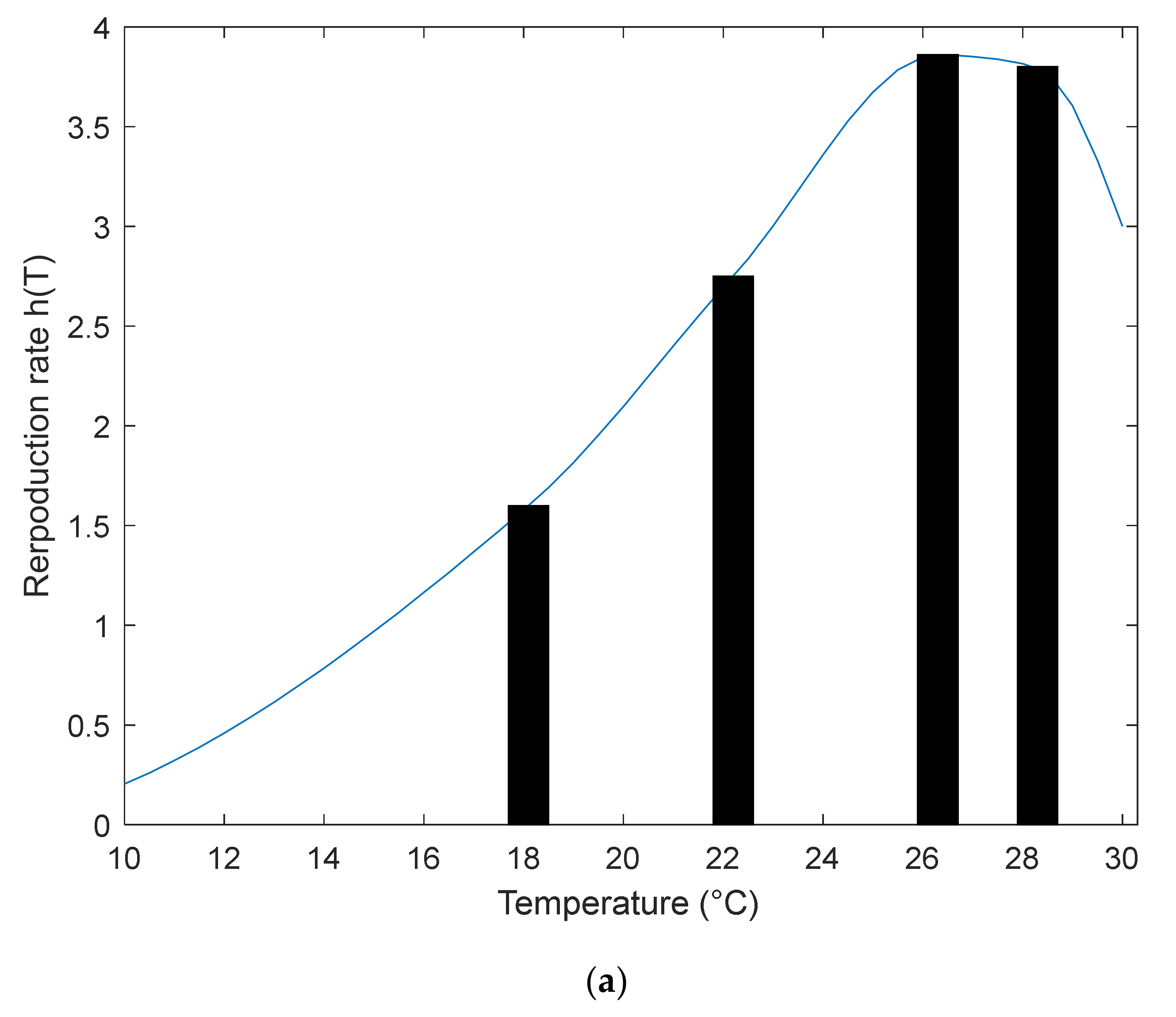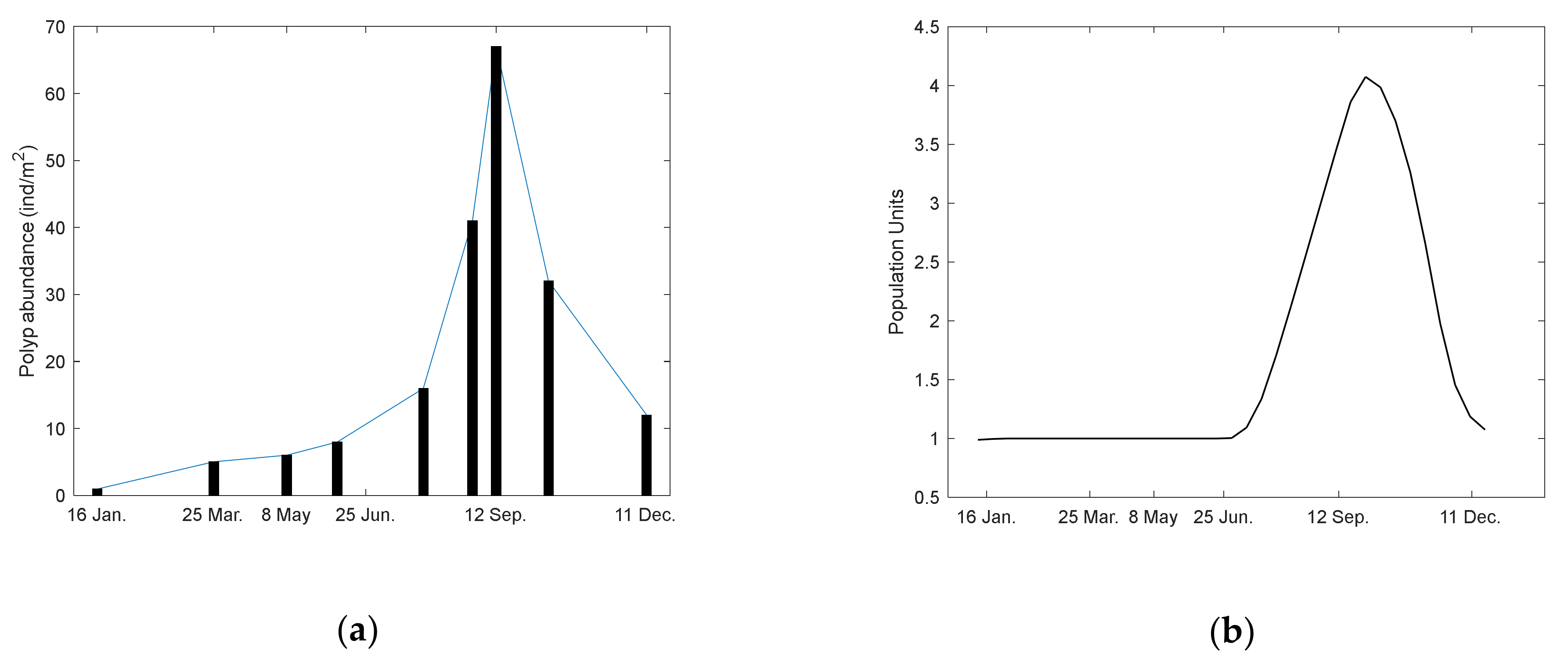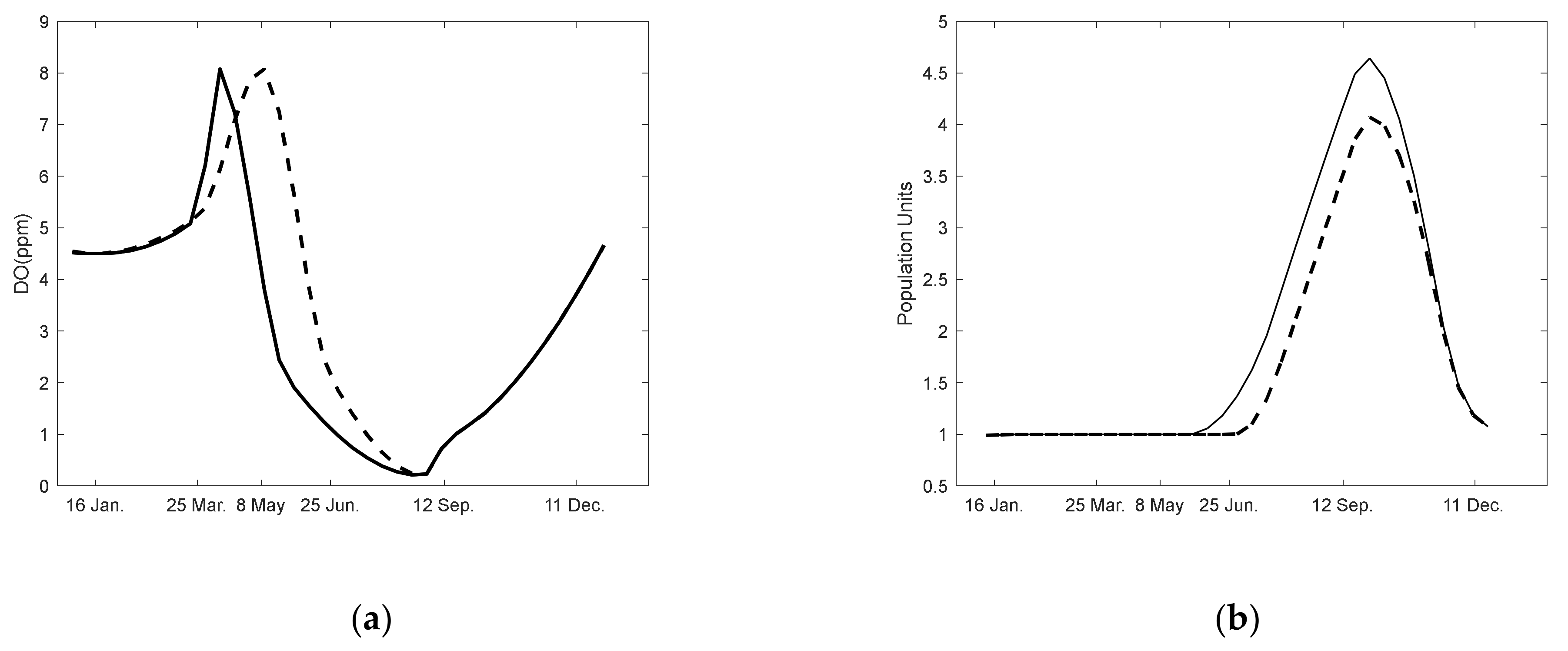Dissolved Oxygen-And Temperature-Dependent Simulation of the Population Dynamics of Moon Jellyfish (Aurelia coerulea) Polyps
Abstract
1. Introduction
2. Methods
2.1. Model
2.2. Algorithm
- The initial polyp population size was set to one unit;
- The basic carrying capacity was set to one unit;
- The DO-dependent survivorship of the polyps was estimated through the sigmoid function:;
- The annual survivorship curve,, was constructed;
- The temperature-dependent reproduction rate was estimated through the interpolating function: . It is constructed by fitting a curve to the experimental data;
- The annual reproduction rate curve,, was constructed;
- The annual reproduction rate polyp was calculated: h(t);
- The population units of polyps over a 1-year period were evaluated using a delay dynamic Equation (1).
2.3. Dissolved Oxygen-Dependent Polyp Survivorship
2.4. Temperature-Dependent Polyp Reproduction Rate
3. Results
4. Discussion
4.1. Survivorship of Polyps Depends on the Thresholds of Hypoxia
4.2. Effects of Hypoxia Appears Some Time Later
4.3. Reproduction Until the Recovery of Normoxia
4.4. Other Factors to Account for the Population of Polyps
5. Conclusions
Author Contributions
Funding
Institutional Review Board Statement
Informed Consent Statement
Data Availability Statement
Acknowledgments
Conflicts of Interest
References
- Service, R.F. Oceanography- New dead zone off Oregon coast hints at sea change in currents. Science 2004, 305, 1099. [Google Scholar] [CrossRef]
- Stow, C.A.; Qian, S.S.; Craig, J.K. Declining threshold for hypoxia in the Gulf of Mexico. Environ. Sci. Technol. 2005, 39, 716–723. [Google Scholar] [CrossRef]
- Stramma, L.; Johnson, G.C.; Sprintall, J.; Mohrholz, V. Expanding oxygen-minimum zones in the tropical oceans. Science 2008, 320, 655–658. [Google Scholar] [CrossRef]
- Chan, F.; Barth, J.A.; Lubchenco, J.; Kirincich, A.; Weeks, H.; Peterson, W.T.; Menge, B.A. Emergence of anoxia in the California current large marine ecosystem. Science 2008, 319, 920. [Google Scholar] [CrossRef] [PubMed]
- Vaquer-Sunyer, R.; Duarte, C.M. Thresholds of hypoxia for marine biodiversity. Proc. Natl. Acad. Sci. USA 2008, 105, 15452–15457. [Google Scholar] [CrossRef]
- Altieri, A.H.; Witman, J.D. Local extinction of a foundation species in a hypoxic estuary: Integrating individuals to ecosystem. Ecology 2006, 87, 717–730. [Google Scholar] [CrossRef] [PubMed]
- Howarth, R.; Chan, F.; Conley, D.J.; Garnier, J.; Doney, S.C.; Marino, R.; Billen, G. Coupled biogeochemical cycles: Eutrophication and hypoxia in temperate estuaries and coastal marine ecosystems. Front. Ecol. Environ. 2011, 9, 18–26. [Google Scholar] [CrossRef]
- Breitburg, D.; Levin, L.A.; Oschlies, A.; Grégoire, M.; Chavez, F.P.; Conley, D.J.; Garçon, V.; Gilbert, D.; Gutiérrez, D.; Isensee, K.; et al. Declining oxygen in the global ocean and coastal waters. Science 2018, 359, eaam7240. [Google Scholar] [CrossRef]
- Diaz, R.J.; Rosenberg, R. Marine benthic hypoxia: A review of its ecological effects and the behavioural responses of benthic macrofauna. Oceanogr. Mar. Biol. 1995, 33, 245–303. [Google Scholar]
- Wu, R.S.S. Hypoxia: From molecular responses to ecosystem responses. Mar. Pollut. Bull. 2002, 45, 35–45. [Google Scholar] [CrossRef]
- Ishii, H.; Ohba, T.; Katsukosh, K. Effects of low dissolved oxygen on planula settlement, polyp growth and asexual reproduction of Aurelia aurita. Plankton Benthos Res. 2008, 3, 107–113. [Google Scholar] [CrossRef]
- Hardin, G. The competitive exclusion principle. Science 1960, 131, 1292–1297. [Google Scholar] [CrossRef] [PubMed]
- Ishii, H.; Katsukosh, K. Seasonal and vertical distribution of Aurelia aurita polyps on a pylon in the innermost part of Tokyo Bay. J. Oceanogr. 2010, 66, 329–336. [Google Scholar] [CrossRef]
- Diaz, R.J. Overview of hypoxia around the world. J. Environ. Qual. 2001, 30, 275–281. [Google Scholar] [CrossRef]
- Amos, C.L.; Martino, S.; Sutherland, T.F.; Al Rashidi, T. Sea surface temperature trends in the coastal zone of British Columbia, Canada. J. Coast. Res. 2015, 31, 434–446. [Google Scholar] [CrossRef]
- Barnett, T.P.; Pierce, D.W.; AchutaRao, K.M.; Gleckler, P.J.; Santer, B.D.; Gregory, J.M.; Washington, W.M. Penetration of human-induced warming into the world’s oceans. Science 2005, 309, 284–287. [Google Scholar] [CrossRef]
- Ocean Warming. Available online: https://www.iucn.org/resources/issues-briefs/ocean-warming (accessed on 26 August 2020).
- Condon, R.H.; Decker, M.B.; Purcell, J.E. Effects of low dissolved oxygen on survival and asexual reproduction of scyphozoan polyps (Chrysaora quinquecirrha). Hydrobiologia 2001, 451, 89–95. [Google Scholar] [CrossRef]
- Dong, Z. Blooms of the moon jellyfish Aurelia: Causes, consequences and controls. In World Seas: An Environmental Evaluation, 2nd ed.; Chales, S., Ed.; Academic Press: Cambridge, MA, USA, 2019; Volume 3, pp. 163–171. [Google Scholar] [CrossRef]
- Yoon, W.; Chae, J.; Koh, B.S.; Han, C. Polyp removal of a bloom forming jellyfish, Aurelia coerulea, in Korean waters and its value evaluation. Ocean Sci. J. 2018, 53, 499–507. [Google Scholar] [CrossRef]
- Han, C.H.; Uye, S.I. Combined effects of food supply and temperature on asexual reproduction and somatic growth of polyps of the common jellyfish Aurelia aurita sl. Plankton Benthos Res. 2010, 5, 98–105. [Google Scholar] [CrossRef]
- Yukalov, V.I.; Yukalova, E.P.; Sornette, D. Population dynamics with nonlinear delayed carrying capacity. Int. J. Bifurc. Chaos 2014, 24, 1450021. [Google Scholar] [CrossRef]
- Jin, H.S.; Han, D.; Kim, J.H.; Shin, H.J.; Yoon, Y.H.; Han, C.H. Simulations of the population dynamics of jellyfish polyps living on artificial substrates in coastal areas. Thalass. Int. J. Mar. Sci. 2017, 33, 43–50. [Google Scholar] [CrossRef]
- Rabalais, N.N.; Turner, R.E.; Wiseman, W.J. Gulf of Mexico hypoxia, aka “The dead zone”. Annu. Rev. Ecol. Syst. 2002, 33, 235–263. [Google Scholar] [CrossRef]
- Villnäs, A.; Norkko, J.; Lukkari, K.; Hewitt, J.; Norkko, A. Consequences of increasing hypoxic disturbance on benthic communities and ecosystem functioning. PLoS ONE 2012, 7, e4492. [Google Scholar] [CrossRef]
- Lim, H.S.; Diaz, R.J.; Hong, J.S.; Schaffner, L.C. Hypoxia and benthic community recovery in Korean coastal waters. Mar. Pollut. Bull. 2006, 52, 1517–1526. [Google Scholar] [CrossRef]






| Parameter | Definition | Comments |
|---|---|---|
| Basic carrying capacity | Dimensionless unit. Set to one unit | |
| Survivorship depending on DO | Values closer to 1 represent better conditions for polyps | |
| Annual DO dependent survivorship | Annual survivorship | |
| Reproduction rate depending on temperature | Assuming food and other conditions are satisfied. | |
| h(t) | Annual temperature-dependent reproduction rate | Assuming food and other conditions are satisfied |
| Reproduction rate depending on DO, temperature, and time | Annual reproduction rate h(t) | |
| Effective carrying capacity | Carrying capacity depending on the population at time | |
| Effective carrying capacity | Constant carrying capacity over the time intervals | |
| Time delay | Feedback time, set to 10 days | |
| Normalized population | Normalized polyp population unit | |
| Polyp population for | Polyp population size before feedback 1 to the present |
| Organisms | SLC50 (mean ± S.E.) (mg O2 L−1) | N | 90th Percentile | Standard Deviation |
|---|---|---|---|---|
| Crustaceans | 3.21 ± 0.28 | 30 | 5.0 | 1.53 |
| Mollusks | 1.99 ± 0.16 | 28 | 2.83 | 0.85 |
| Cnidarians | 0.69 ± 0.11 | 19 | 1.43 | 0.48 |
| Concentration (mg O2 L−1) | 2.83 | 1.99 | 0.91 | 0.60 |
|---|---|---|---|---|
| 0.10 | 0.50 | 0.90 | 0.95 |
Publisher’s Note: MDPI stays neutral with regard to jurisdictional claims in published maps and institutional affiliations. |
© 2021 by the authors. Licensee MDPI, Basel, Switzerland. This article is an open access article distributed under the terms and conditions of the Creative Commons Attribution (CC BY) license (https://creativecommons.org/licenses/by/4.0/).
Share and Cite
Jin, H.; Kim, K.; Choi, I.; Han, D. Dissolved Oxygen-And Temperature-Dependent Simulation of the Population Dynamics of Moon Jellyfish (Aurelia coerulea) Polyps. Diversity 2021, 13, 184. https://doi.org/10.3390/d13050184
Jin H, Kim K, Choi I, Han D. Dissolved Oxygen-And Temperature-Dependent Simulation of the Population Dynamics of Moon Jellyfish (Aurelia coerulea) Polyps. Diversity. 2021; 13(5):184. https://doi.org/10.3390/d13050184
Chicago/Turabian StyleJin, Hongsung, Kwangyoung Kim, Ilsu Choi, and Dongyeob Han. 2021. "Dissolved Oxygen-And Temperature-Dependent Simulation of the Population Dynamics of Moon Jellyfish (Aurelia coerulea) Polyps" Diversity 13, no. 5: 184. https://doi.org/10.3390/d13050184
APA StyleJin, H., Kim, K., Choi, I., & Han, D. (2021). Dissolved Oxygen-And Temperature-Dependent Simulation of the Population Dynamics of Moon Jellyfish (Aurelia coerulea) Polyps. Diversity, 13(5), 184. https://doi.org/10.3390/d13050184






